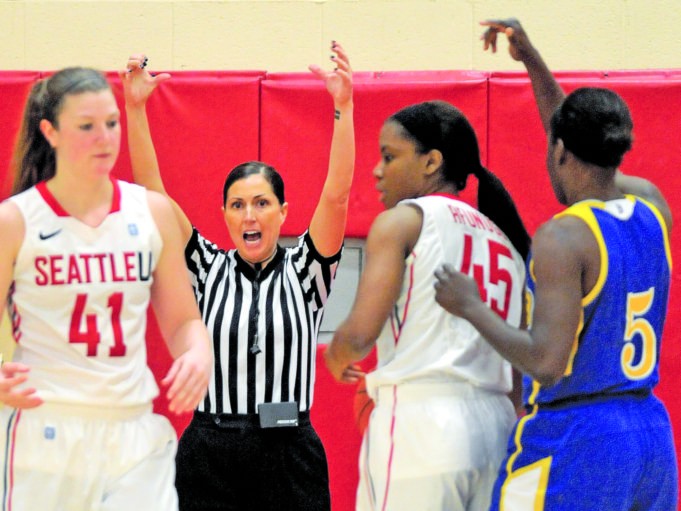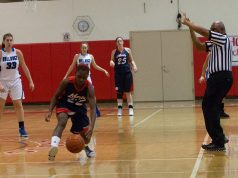There you are, just cruising along in a basketball game. Everything is going smoothly, and then all of a sudden — bang! All hell breaks loose. What happened? “Why did that coach explode on that play?” “Gee, I hope I got that play right, because that’s the last nail in the coffin.” “Oh my god, we needed a whistle there!” “Crap, and that was his or her fifth foul too …”
Ever have any of those thoughts? Be honest. We all have. But what can we learn from those situations? Should we have seen them coming? In most cases, the game will give you “caution signs” if you pay attention. But the overwhelming problem is that officials generally rely on their reactions to get through a game. And even if their reactions are normally good, all it takes is one bad one at the wrong time to blow up the game.
So how do we see the caution signs? Well, first realize that you’re standing in the middle of a minefield! Don’t panic, you can get through this — all you need is to apply some “elevated thinking.” To avoid shrapnel, you need to think your way though a game. “Elevated thinking” is about knowing where the danger lies in officiating.
When you examine why and when we get yelled at, it often boils down to not only making marginal calls, or missing illegal plays, but also includes the circumstances surrounding them. If you know where and when it can be dangerous, you then can raise your awareness to make solid decisions versus relying on just reacting to plays.
We all know that a marginal call can frustrate players, coaches and fans. And the same can be said for when we miss a call that is obvious to everyone. But those situations are not created equal. Some incidents end up being more explosive than others. That realization led Darron George, NCAA D-I men’s official, along with his co-camp director, NBA official Pat Fraher, to run the Elevate Officiating camp (elevateofficiating.com) and to identify four “land mines” of play calling. Let’s examine the minefields in regard to missed or marginal plays.
Marginal Call Land Mine 1: Impact players
Some players are better than others. It’s always been that way, and always will be. They are called impact players because they have an impact on the game, and on their team’s chances of winning. Does that mean they should receive special treatment? No. But you better know where they are. Everyone’s eyes are on the “key match-up.” “Coaches pregame them, announcers analyze them and we better identify them,” George said. “When we call a marginal play against an impact player, that whistle has a consequence. It may cause a substitution, or worse yet, a disqualification. It may mean free throws or points scored. Both of those can severely impact a team’s chances of success, which is why coaches, players and fans go nuts on those plays. The problem is that those situations act as double-edged swords, because if you miss a play, or call a marginal play, for them or against them, there will be a major reaction.”
The point is an elevated awareness is needed. It doesn’t change your judgment, but hopefully will keep you from merely reacting on the plays, and induce you to make a decision instead.
Marginal Call Land Mine 2: Key times
It’s obvious that as time is running out, a bad call (or no-call) can have huge consequences because there won’t be any time for the offended team to overcome it. Those include violations as well as fouls because possessions become increasingly important down the stretch. So when are the key times? “The end of the game is the most obvious, but the same thinking can be applied to the end of the half, end of a quarter and even the end of a shot clock. As time runs down, our awareness should ramp up. It is critical that we make decisions versus reactions at these times,” George said.
Marginal Call Land Mine 3: Lopsided scenarios
Why should we care if things are lopsided? It’s not our job to make things even.
“That’s true, but believe it or not, referees can screw up a 20-point game, too,” George pointed out. “It’s been said that when things are lopsided in a game, ‘One team is playing downhill and the other playing uphill.’ Playing downhill means everything is coming easily to them — they’re cruising. Playing uphill means everything is hard, momentum is tough to come by — they’re struggling. Whether it’s the score, free throws or team fouls that are lopsided, we sometimes insert ‘speed bumps’ into the game in the form of marginal calls or missed plays. Approaching those speed bumps can be dangerous from either direction. We must avoid making marginal calls against the struggling team, and at the same time we must not miss illegal plays against the team that’s cruising. Those two different mistakes tend to act as the ‘straw that broke the camel’s back.’ Let’s be clear: That is not to be confused with calling marginal plays against the team that is up, or letting illegal plays go against the team down. That is not game management; that is game manipulation.”
Marginal Call Land Mine 4: Outside of our primaries
When we decide to make marginal calls from outside of our primaries, we put ourselves, as well as our crew, in danger.
“By doing so, we wreck our own credibility in judgment, and demonstrate that we don’t trust our partner’s judgment as well. We set up the expectation that we will come in from anywhere on any future contested play in the game. On the other hand, when we fail as a crew to call a play that is blatantly obvious to everyone, the whole crew will go down together. Those types of plays cannot be missed by the crew. We can’t simply ‘let our partner live and die with it,’ or think ‘that isn’t my call,’” George said. “Blatant plays need whistles — from somewhere, anywhere.”
You have now been briefed on land mines. Use your head, and good luck.
What's Your Call? Leave a Comment:
Note: This article is archival in nature. Rules, interpretations, mechanics, philosophies and other information may or may not be correct for the current year.
This article is the copyright of ©Referee Enterprises, Inc., and may not be republished in whole or in part online, in print or in any capacity without expressed written permission from Referee. The article is made available for educational use by individuals.


















